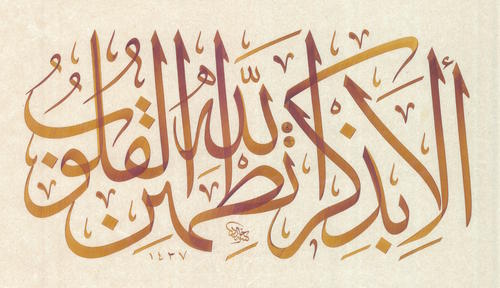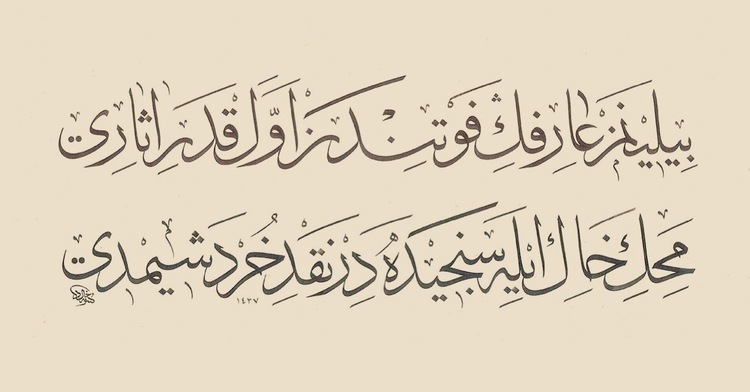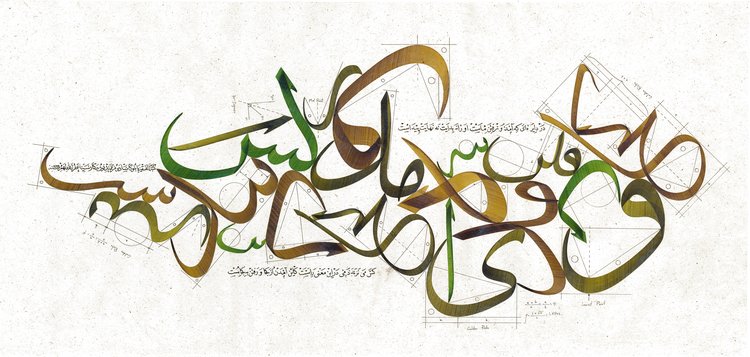As Aristotle said, “Patience is bitter, but its fruit is sweet.” Calligraphy is a discipline that requires both practice and patience. When I met Khalid, exactly two years ago, the first thing I noticed about him was his great patience when writing calligraphy. He would produce these impeccable lines of letters, but with great deliberation. This is one of the biggest challenges for most beginning calligraphy students: to be able to slow down and write with patience. Personally, I struggle with it on a daily basis when practicing my lessons.
Pablo Khalid Casado is a master calligrapher from Spain. He studied with several great masters in Turkey and Spain, including, master calligrapher Nuria Garcia Masip, and Turkish masters Hasan Celebi and Ferhat Kurlu. He received his Icazet (diploma) in 2014 in both thuluth and naskh scripts from IRCICA (Research Center of Islamic Art, History and Culture) in Istanbul, Turkey. He has taught classes in U.S., Europe and the Middle East.
What is the most difficult thing for a calligraphy student to learn?
There isn’t one thing in particular that you can say is the most difficult thing, but everything can be hard at the same time. At the beginning everything is a challenge, dealing with the proportions or the different angles, getting used to the qalam [(pen)] and understanding how it works, being able to get the proper mixture between ink and water, you don't want it too dry or too wet, understanding the [texture of the] paper or keeping a steady hand while you are writing. In calligraphy everything takes a lot of time to be learned, so, specially at the beginning, everything might seems difficult, but is just a matter of time.
What should beginners students focus on?
The main thing a beginner student should focus is in not loosing hope and keep practicing every single day. Calligraphy doesn't just improve your skills of penmanship, but it improves other aspects [of personality] like patience or self discipline, which are [both] essentials to becoming a calligrapher.
How do you stay connected with your teachers in Turkey and France?
I try to visit them in Istanbul as much as I can, but sometimes it's quite difficult due to a very tight agenda specially in the last couple of years, so email is always an option although not the best one. With my teacher Nuria, I'm in touch almost weekly, so I will send her every single piece I'm working on, and she will send me all the corrections back. I feel blessed to have her as my teacher, as she has been really helping me a lot since minute one. Nothing of what I currently do would have been possible without her.
How many hours of calligraphy should a student practice calligraphy in a day?
I don't think there is a determinate amount of hours for a student to practice calligraphy in a day, but the longer the better. Typically, I refer to what our teacher Hassan Çelebi usually says, which is a student should be practicing for 25 hours per day — a good way of saying that we should take the daily practice seriously. Sometimes if you just can sit down and focus for 45 minutes, or one hour, it is definitely better than nothing.
Who is your favorite historical calligrapher?
Would be hard to pick up just one calligrapher as my favorite, but there are a few like Sevki Efendi, Sami Efendi, Nazif Bey, Kamil Akdik or Halim who I will always look at and carefully study. I analyze their works in order to learn from them.
Gallery of Khalid's work (courtesy of sacred-lines.com)






